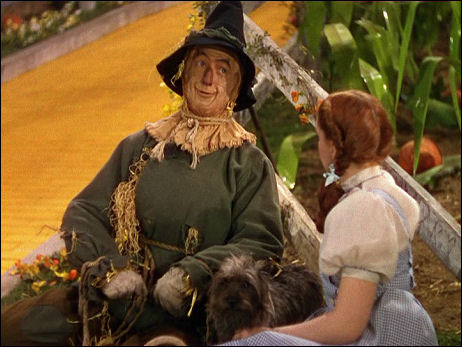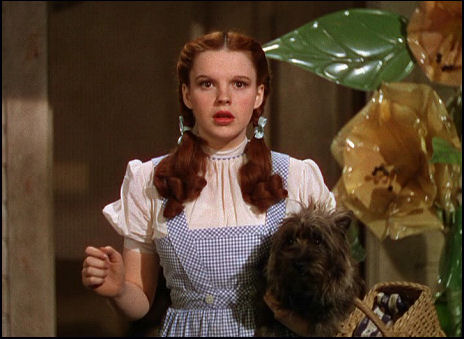This morning I heard from and then spoke to restoration guru Robert Harris (The Godfather, Lawrence of Arabia, Vertigo, Spartacus) about my 9.18 reaction to the forthcoming Wizard of Oz Blu-ray — i.e, “much sharper and more vivid, bursting with color, splendorific,” etc. Harris admires the disc as much as I do and probably more so. He’s fine with the grain. But he didn’t disagree with my observation about it being “somewhat grainier,” and conceded that the film now looks different than the one that 1939 audiences saw.

The new Wizard is an example of “a basic Blu-ray trade-off,” I wrote. “The grain that is in the negative is brought out in a way that catches your eye like never before. It’s not a problem, but there’s no ignoring it. I’m not putting the grainy aspect down, per se. I fully respect the decision of Warner Home Video technicians not to clean or digitally tweak or Patton-ize the original 1939 elements — but I am saying that Dorothy Gale, Auntie Em, Uncle Henry and the three farm hands are now covered in billions of micro-mosquitoes that I hadn’t been as aware of in years past.”
Harris wrote that “viewers in 1939, 1954 and beyond never saw the grain in Technicolor films because the process did not reproduce it. Between the optics of the era, the optical printing process toward the creation of printing matrices, the metal dye imbibition system, the mordant in use at the time, as well as imperfect registration, which was covered by the overall softness…Technicolor films had a wonderful, almost grain-free, velvety look, which is nothing like the new Blu-ray.
“There are many ways to skin a cat. The new Wizard of Oz Blu-ray, which faithfully reproduces the grain structure of the original negatives (with the exception of the opening reel, which is from a dupe source), is one of them.
“Leaving the original grain structure in was a technical decision. WHV technicians have delivered an excellent piece of work, but the Oz Blu-ray has a pronounced grain that wasn’t there when audiences first saw the film. The image is now very sharp, albeit with the original grain structure. But trying to eliminate the grain can lead to a very tenuous situation at best, as each shot must be worked over to make certain that problems do not arise.”

We then spoke on the phone and Harris re-explained:
“There are many ways to reduce grain,” he said. “Either you throw the film out of focus, which is what most people do, and then you sharpen it slightly and raise the contrast. Or you send it to Lowry Digital, which is the only shop in town which has the ability to reduce grain without losing resolution.
“The people who made The Wizard of Oz 70 years ago knew what would show up and what wouldn’t,” he pointed out. “The final result was a beautiful, velvety, slightly soft-focus print with good contrast to it, and it looked gorgeous on screen.
“But if you take the original negattve and then show it to the public [as WHV has with its new Blu-ray], you’re going to see the original grain structure that the original audiences never saw. But if you remove it…if you remove the grain and you hold the resolution then you’re going to see the wigs and make-up, sets, costume details all the other problems.
“The other way – the Lowry way — is to remove the grain, increase the resolution and then put back in a slight level of grain to make it look like film. But one has to acknowledge that whomever is leading the project is going to have to carefully examine every shot in the film to make very certain that they aren’t opening the proverbial Pandora’s box, and creating problems that were never there before.
“Warner Home Video did nothing wrong. They did a great job within their criteria, and I don’t have a problem with it. God knows if you lessen any grain on an older film in any primitve way, you’re really asking for trouble. Like Fox got into trouble with the overly scrubbed-down Blu-rays of Patton and The Longest Day.

“And if you take all the grain out, as the Lowry people can, it’s like you’re watching the actors through a very clean window. But with older films, like Michael Curtiz‘s Robin Hood, removing too much grain can make some of the armor looks like painted cardboard, and then you’re seeing things that were never meant to be seen.”
Harris suggested at the end of our conversation that I might want to slightly turn down the sharpness level on my 42-inch plasma. I said I might. But then I thought about this later on and reminded myself that I adore the sharpness level, and that pretty much every Blu-ray I’ve watched on it looks fantastic so why should I futz around with it just so The Wizard of Oz looks less grainy?
